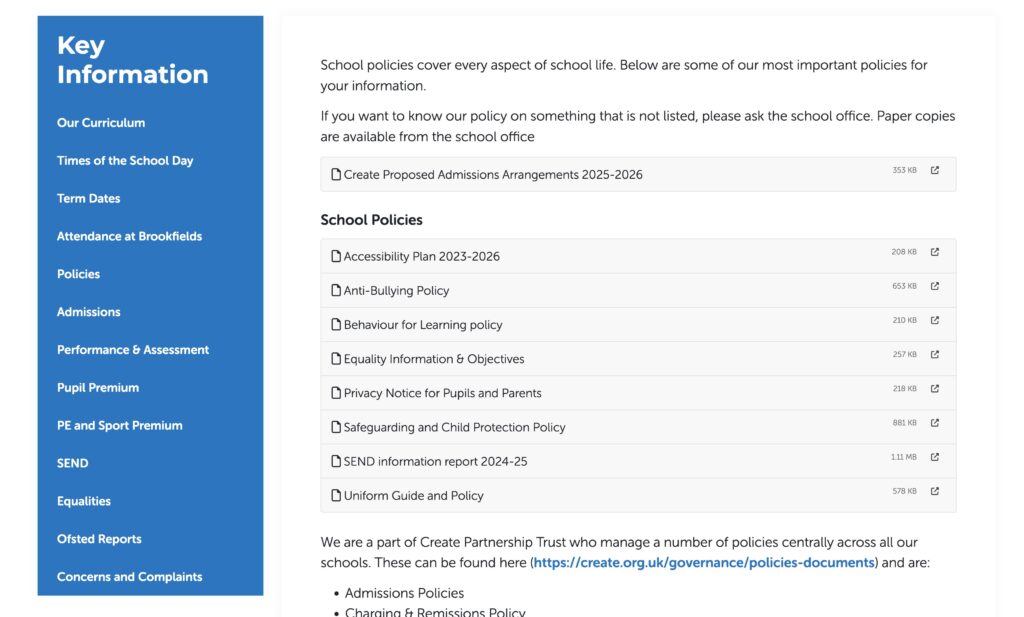Chapter 1
What’s New for 2025/26?
This year, there’s a sharper focus on areas like executive pay transparency and gender pay gap reporting—even for smaller schools and trusts. Ofsted is also placing increased emphasis on the clarity and quality of curriculum content, the accessibility of your policies, and the way you present support for children with SEND. It’s no longer enough to simply tick a box—your website needs to show how you do what you say you do.
I’ve updated this guide to reflect everything you need to know this year, including practical steps, tips, and examples from schools and trusts that are getting it right. Whether you’re responsible for one school or an entire trust, my aim is to make staying compliant not only easier—but something that strengthens your school’s story.
And if you’d like a bit of extra help or the chance to ask questions live, I’d love you to join me for one of our free monthly School Website Compliance Workshops. You can book your place here:

 “Each year, school website requirements change—sometimes subtly, sometimes significantly. For 2025/26, the updates might look small at first glance, but the expectations behind them are growing fast.
“Each year, school website requirements change—sometimes subtly, sometimes significantly. For 2025/26, the updates might look small at first glance, but the expectations behind them are growing fast.This year, there’s a sharper focus on areas like executive pay transparency and gender pay gap reporting—even for smaller schools and trusts. Ofsted is also placing increased emphasis on the clarity and quality of curriculum content, the accessibility of your policies, and the way you present support for children with SEND. It’s no longer enough to simply tick a box—your website needs to show how you do what you say you do.
I’ve updated this guide to reflect everything you need to know this year, including practical steps, tips, and examples from schools and trusts that are getting it right. Whether you’re responsible for one school or an entire trust, my aim is to make staying compliant not only easier—but something that strengthens your school’s story.
And if you’d like a bit of extra help or the chance to ask questions live, I’d love you to join me for one of our free monthly School Website Compliance Workshops. You can book your place here:
Latest School Website Requirements
Last updated for 2025/26
Staying compliant isn’t just about checking boxes—it’s about showing your school or trust is well-run, transparent, and focused on students. The very best schools don’t wait for Ofsted to update their website; they use it year-round to show how they live out their values and policies every day.
Let us know if you’d like to book a one-to-one call to talk through any requirements—we’re here to help.
7 Top Tips for School Website Compliance
Our in-house team supports hundreds of schools and trusts every year. We listen closely to what inspectors look for and what real users experience. Here’s what we know for certain: compliance isn’t just about ticking boxes—it’s about building confidence.
So before you dive into the full checklist, here are seven key strategies to help you get it right—and keep it right.
Presenting Policies & Documents – Best Practice for Schools and Trusts
Policies might not be the most exciting content on your website—but they are among the most important. Not just because they’re required, but because they’re often one of the first places inspectors, parents and other stakeholders look when judging how well-run your school or trust is.

It’s not just about publishing your policies. It’s about making them clear, accessible and easy to manage over time.
Why Presentation Matters
Your policy page may not change often, but it must stand the test of time. Many schools redesign their website every 3–4 years, so the way you present policies today is likely to stick for a while. If your documents are in one long, hard-to-navigate list, or links are broken, it doesn’t just frustrate visitors—it can lead to serious compliance concerns. Inspectors may flag missing or outdated content even if your policy is technically live somewhere on the site.
And remember: some policies must include references to legislation in the introduction or overview. This is a common oversight, so double-check before uploading.

How to Display Policies Effectively
- Group policies into categories (e.g. Safeguarding, Curriculum, Finance). This is far easier for users to scan and understand.
- Style the policy section clearly. Even something simple like an icon or download button improves usability.
- Avoid dead links and outdated files. This is one of the most common (and unnecessary) compliance failures.
- Enable in-page previews where possible. This keeps users on your site and aligns with accessibility expectations.
- Use readable, accessible PDF files, not scanned documents or huge downloads.
The Schudio Solution: Document Groups
- All Schudio-powered websites include a powerful feature called Document Groups. This module lets you:
- Upload policies once and display them in multiple places on your website.
- Automatically update all versions when a policy is changed—no duplicate uploads.
- Sort and group policies into a structured, user-friendly layout.
- Embed live, searchable document sections anywhere on your site.
For example, your SEND policy might appear both on your Policies page and your SEND page. Update it once, and it’s updated everywhere.
Managing Policies Across Multi-Academy Trusts
For MATs, the need for centralised policy control is even more critical.
Using the Schudio MAT Portal, trusts can:
✔ Upload and manage policy documents centrally
✔ Distribute and publish documents across all school websites—even if schools use different website providers
✔ Automatically update policy links trust-wide from one dashboard
✔ Reduce admin time and ensure consistent compliance across the trust
This doesn’t just make policy management easier. It protects your schools from accidental non-compliance, ensures consistency, and gives peace of mind at leadership level.
Final Tip
Don’t treat your policies like background files. Treat them like front-facing evidence of your school’s or trust’s commitment to excellence, transparency, and statutory responsibility. Display them well—and manage them smartly. If you need help reviewing your current setup or want to centralise policy management for your MAT, get in touch with our team. We’re happy to help.
The School Website Checklist 2025/26
Last updated September 2025
 The statutory requirements for school and college websites continue to evolve—and staying compliant means staying proactive.
The statutory requirements for school and college websites continue to evolve—and staying compliant means staying proactive.
This definitive School Website Checklist is fully up to date with the latest guidance from the Department for Education and includes everything that Ofsted expects to see. Whether you’re preparing for an inspection or just want to stay ahead, this is your go-to tool.
As always, if you need support while working through the checklist, our team is here to help. You can book a free call any time.
The admission arrangements section is different depending on your school type and who determines your admissions. Every maintained school and academy trust must publish their admission arrangements to comply with the:
Foundation and voluntary aided schools have specific responsibilities regarding the information they must publish, especially concerning admission arrangements and performance measures. They must also follow updates in various sections of guidance, including governance and diversity, to ensure transparency and compliance with regulations.
The school admissions and appeals codes do not apply to special academies, alternative provision settings or stand-alone 16 to 19 institutions.
Additional information is available in the government guidance for school leaders and staff on developing and publishing your school’s behaviour policy.
This information has been simplified to be more clear and easy to understand. The information below has been collated from the requirements published by DfE and restructured to be easier to understand and implement.
Guidance on charging for school activities is available. Sections 449 to 462 of the Education Act 1996 set out the law on charging in schools maintained by local authorities. Academies are required by their funding agreement to comply.
All schools and colleges should publish details about their complaints policies and procedures.
Read guidance on developing your school’s complaints procedure.
NOTE: Schools that do not have a website
Schools that do not have their own website must publish this information on an alternative website and provide parents and carers with a link to it.
EXPLAINED: You must still publish all of the information which is set out on this webpage online even if you do not maintain your own website. You can use an alternative website to host the information as long as you make the address and details of the website known to parents, for example, by providing parents with the URL (website address) and any other relevant details.
This requirement is for information about the curriculum being taught at your school to be presented on your website. Some requirements are education phase specific. The information below has been collated from the requirements published by DfE to avoid duplication and make the information easier to understand.
Make sure you cover all the requirements appropriate for the phases taught at your school. Consider backing up your curriculum information up with regular blog posts demonstrating work.
NOTE for all schools: Your approach to the curriculum should also include how you are complying with your duties in the Equality Act 2010 and the Special Educational Needs and Disability Regulations 2014 about making the curriculum accessible for those with disabilities or special educational needs.
These requirements are specific to academy trusts and FE colleges. There is no requirement for academies to publish information related to the trust, nor is there a requirement for maintained schools to publish this information.
These requirements are specific to maintained schools. Note that this requirement includes the previously separate requirement for linking to the benchmarking service.
Schools must publish on their website up-to-date details of its governance arrangements in a readily accessible form. The details below have been broken down by school type.
Maintained Schools publish information on the governing body in line with the constitution of governing bodies of maintained schools statutory guidance.
Academies can follow details as explained in the ‘Academies financial handbook’ (paragraphs 2.49 to 2.50).
All schools are required to do one of the following. See the Schudio Tip below for best practice advice.
This is an entirely new requirement with different requirements for all organisations. Note how the advice is to publish this information no matter what size organisation you are. We have collated the requirements to make this easier to understand and implement.
Previously titled, Equality Objectives – Public bodies, must comply with the public sector equality duty in the Equality Act 2010 and the Equality Act 2010 (Specific Duties and Public Authorities) Regulations 2017. The Equality Act 2010 and Advice for Schools provide information as to how your school can demonstrate compliance.
This requirement was new in 2022 and is still missed by lots of schools. Schools should publish on their website their opening and closing times and the total time this amounts to in a typical week (for example 32.5 hours).
Schools should show the compulsory times they are open. This time runs from the official start of the school day (morning registration) to the official end of the compulsory school day. It includes breaks, but not optional before or after school activities.
This requirement was new in 2022 and is still missed by lots of schools. The department produces statutory guidance on the cost of school uniforms which schools must have regard to when developing and implementing their school uniform policy. This guidance requires schools to publish their uniform policy on their website.
You must publish a report on your school’s policy for pupils with SEN and update it annually. You should update any changes occurring during the year as soon as possible. The report must comply with section 69 of the Children and Families Act 2014.
We have combined the requirements below and worked on the basis that where some requirements for academies are marked as ‘should’ by DfE, we have marked these as ‘must’ for ease of understanding and implementation. So, all requirements below should be understood to be mandatory for all schools, where the key stage is applicable.
This list of requirements is NOT published on the main requirements pages currently but as of September 2019 the guidelines around Keeping Children Safe in Education makes specific mention of the requirement to publish safeguarding information on the school website.
In an inspection, the lead inspector will prepare for the inspection by gaining an overview of the school’s recent performance, and any changes since the last inspection. There is also a requirement around making some of your safeguarding information available publicly, with your website being the specific medium mentioned to do this.
Final Thoughts and Next Steps
Thanks so much for taking the time to work through this guide.
I know how busy things are in school and how easy it is to push website compliance down the list—but the truth is, this work really matters. Not just because Ofsted is watching (though they are), but because your school website is the very first place most people go to form a picture of your school. Getting this right makes a real difference—to parents, to inspectors, and to the confidence of your whole team.
If you’ve worked through the checklist and feel confident you’re on track, that’s brilliant. If you’ve found a few areas where things need tightening up, that’s normal—and that’s exactly what this guide is here to help with.
Whether you’re tackling compliance on your own or leading it across a Trust, you’re not alone. I’d love to invite you to our free monthly School Website Compliance Workshop, where I walk through all the latest requirements and offer live audits and advice. It’s a great space to ask questions, share challenges, and learn from other schools. You can book your place here:

 Make content easy and fast to find
Make content easy and fast to find Safeguarding: non-negotiable
Safeguarding: non-negotiable Work systematically with a set schedule
Work systematically with a set schedule School Website Accessibility matters (and is a legal requirement)
School Website Accessibility matters (and is a legal requirement) Should you rely on an Ofsted Early Warning System?
Should you rely on an Ofsted Early Warning System? MATs face unique challenges—but they also have the biggest opportunities. With the right tools, you can manage policy updates, compliance tracking and content deployment across all your schools from one central hub.
MATs face unique challenges—but they also have the biggest opportunities. With the right tools, you can manage policy updates, compliance tracking and content deployment across all your schools from one central hub. With the rise of AI tools, many schools are exploring automated ways to manage website content. We support responsible use of AI—but we’ve also seen the risks.
With the rise of AI tools, many schools are exploring automated ways to manage website content. We support responsible use of AI—but we’ve also seen the risks.
